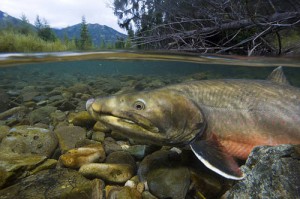FOR IMMEDIATE RELEASE
July 11, 2014
Nick Cady, Cascadia Wildlands, 314-482-3746
John Meyer, Cottonwood Environmental Law Center, 406-587-5800
Travis Bruner, Western Watersheds Project, 208-788-2290
Sarah Peters, WildEarth Guardians, 541-345-0299

Bull trout require cold, clear water for survival. (Photo by USFWS)
in Montana and Idaho, into Canada, and in the Klamath River basin of south-central Oregon. Unfortunately, human activities have driven the trout close to extinction. Activities adjacent to streams, such as logging, grazing, road construction, and off-road vehicle use, increase water temperature and add sediment to bull trout habitat. Of all fish species found in western rivers and streams, bull trout need the coldest and cleanest water, making them particularly vulnerable to water quality impacts.
Bull trout were protected as a threatened species in 1999 and critical habitat was designated in 2010. Designated critical habitat for the bull trout includes 19,729 miles of stream and 488,251.7 acres of reservoirs and lakes in the States of Washington, Oregon, Nevada, Idaho, and Montana. With this designation, the Forest Service and Bureau of Land Management were required to consult with the Fish and Wildlife Service. Consultation requires the agency to take a step back from on-going and proposed management actions to make sure bull trout are recovering in these specially protected areas.
“Unfortunately, the Forest Service and Bureau of Land Management have continued with business as usual,” said Travis Bruner, Executive Director of Western Watersheds Project “We hope that this notice causes them to change course and start protecting bull trout.”
“Bull trout are the ‘canary in the coal mine’ for water quality and water quantity in western states,” said Sarah Peters of WildEarth Guardians. “Protecting them protects a whole suite of aquatic species as well as the watersheds on which human communities increasingly depend.”
“The Forest Service and Bureau of Land Management need a ‘time out’ until they talk to fish experts about the impacts of their landscape management projects on the imperiled bull trout,” says Nick Cady, Legal Director with Cascadia Wildlands. “Otherwise, this iconic fish will continue its perilous journey towards extinction.”
